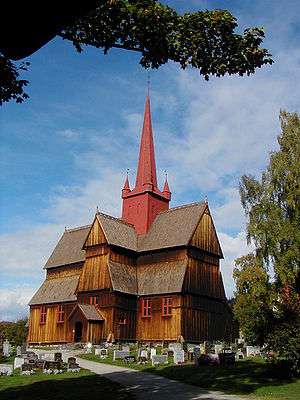Ringebu Stave Church
| Ringebu Stave Church | |
|---|---|
 | |
| Basic information | |
| Location | Ringebu, Norway |
| Geographic coordinates | 61°30′31.82″N 10°10′23.60″E / 61.5088389°N 10.1732222°ECoordinates: 61°30′31.82″N 10°10′23.60″E / 61.5088389°N 10.1732222°E |
| Affiliation | Church of Norway |
| Ecclesiastical or organizational status | Stave church |
| Website | Ringebu stave church on Commons |
| Architectural description | |
| Architectural type | Stave church and timber frame (trellis) |
| Architectural style | Romanesque |
| Completed | ca. 1220. Extended in 1630, higher tower, Crossing and choir, new vestry, by Werner Olsen. |
| Spire(s) | 1 |
| Materials | Wood |
Ringebu Stave Church (Norwegian: Ringebu stavkyrkje) is a stave church located in Ringebu in Ringebu municipality, Gudbrandsdal, Norway. Built in the first quarter of the 13th century, and dated according to coins found during archeologic surveys.
History
The church is first mentioned in 1270, although it could be older.
It was rebuilt into a cruciform church around 1630 by master-builder Werner Olsen and in 1631 received its characteristic red tower. Of the original church only the nave remains, with free-standing posts in the inner area.
Later restoration brought it back a bit closer to its original shape in 1921.
The church was painted in 1717, but only the lower half of the walls were done, since the ceiling at that time was lower. At one point the church was painted white within, but during the restoration work in 1921 the church interior was restored to its original colouring.
There have been some archaeological surveys of the ground under the church. The last one took place in 1980 - 1981. These surveys have resulted in the finding of about 900 old coins, mostly from the medieval times, especially from the period 1217 - 1263.
Post holes from an older church has also been found. The post church is assumed to be a forerunner of the stave church. The earth-bound posts of these churches were planted directly into the ground, and therefore they were exposed to humidity which caused them to rot over the years.
External links
- Ringebu stave church in Stavkirke.org — in Norwegian
- Ringebu stave church (site has pages in English, Norwegian and German)